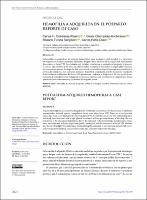| dc.contributor.author | Contreras-Pizarro, Carlos H. | |
| dc.contributor.author | Chumpitaz-Anchiraico, Gloria | |
| dc.contributor.author | Ticona Sanjínez, Rosario | |
| dc.contributor.author | Peña-Diaz, Carlos | |
| dc.date.accessioned | 2023-11-30T01:39:43Z | |
| dc.date.available | 2023-11-30T01:39:43Z | |
| dc.date.issued | 2023-06-30 | |
| dc.identifier.citation | Revista Peruana de Medicina Experimental y Salud Pública. 2023; 40(2). | es_PE |
| dc.identifier.uri | https://hdl.handle.net/20.500.12959/4619 | |
| dc.description.abstract | La hemofilia A adquirida es un trastorno hemorrágico poco frecuente a nivel mundial, y se caracteriza por la presencia de autoanticuerpos inhibidores dirigidos hacia un factor de la coagulación, en la mayoría de ocasiones el factor VIII. Las etiologías son variadas, entre las que se encuentra el posparto. Se presenta el caso de una paciente de 34 años con dolor lumbar, hematuria y hematoma en región glútea derecha, sin antecedentes previos de sangrado. Por extensión de las manifestaciones hemorrágicas es transferida al servicio de emergencia. Los exámenes auxiliares de perfil de coagulación, prueba de mezclas y medición de los títulos de inhibidores del factor VIII permitieron confirmar el diagnóstico. El caso resalta la im-portancia de considerar esta patología en una paciente puérpera con persistencia de sangrado por herida operatoria, hematoma extenso y sin historia de sangrado previo | es_PE |
| dc.description.abstract | Acquired hemophilia A is a rare bleeding disorder worldwide, characterized by the presence of inhibitory autoantibodies directed against a coagulation factor, most often factor VIII. There are several possible causes, and it can occur during the postpartum period. We present the case of a 34-year-old female patient with back pain, hematuria and a right gluteal hematoma, with no previous history of bleeding. She was transferred to the emergency department due to the extension of the hemorrhagic manifestations. Diag-nosis was confirmed with the coagulation profile, mixing test and the assessment of factor VIII inhibitor tier. The case highlights the importance of considering this condition in a postpartum patient with persis-tent postoperative bleeding, extensive hematoma and no history of previous bleeding | es_PE |
| dc.format | application/pdf | es_PE |
| dc.language.iso | spa | es_PE |
| dc.publisher | Instituto Nacional de Salud | es_PE |
| dc.relation.uri | https://rpmesp.ins.gob.pe/index.php/rpmesp/article/view/12593 | es_PE |
| dc.rights | info:eu-repo/semantics/openAccess | es_PE |
| dc.rights.uri | https://creativecommons.org/licenses/by-nc-sa/4.0/ | es_PE |
| dc.subject | Hemofilia A | es_PE |
| dc.subject | Periodo Posparto | es_PE |
| dc.subject | Dolor de la Región Lumbar | es_PE |
| dc.subject | Hematuria | es_PE |
| dc.subject | Hemophilia A | es_PE |
| dc.subject | Postpartum Period | es_PE |
| dc.subject | Back Pain | es_PE |
| dc.title | Hemofilia A adquirida en el posparto: reporte de caso | es_PE |
| dc.title.alternative | Postpartum-acquired hemophilia A: case report | es_PE |
| dc.type | info:eu-repo/semantics/article | es_PE |
| dc.subject.ocde | https://purl.org/pe-repo/ocde/ford#3.02.06 | es_PE |
| dc.identifier.doi | https://doi.org/10.17843/rpmesp.2023.402.12593 | |






